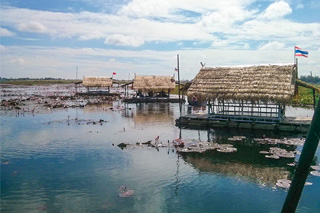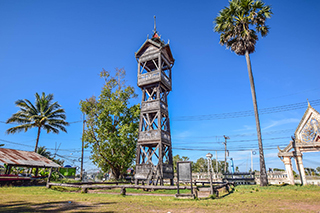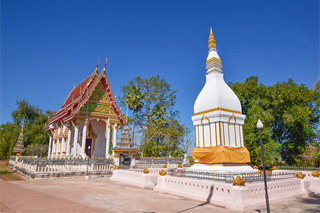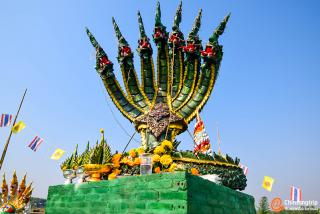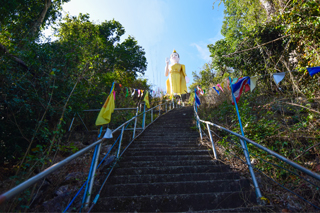Phra That Chom Si is one of the significant and sacred sites dating back to the years 2420-2430 B.E. This area gained attention from the local elder, who heard about the abundant natural resources in the Nong Han River Basin, including fertile land and food resources like rice and fish.
Motivated by this information, the elder decided to journey to the Nong Han River Basin, bringing along nine elephants. He had established a strong relationship with the community of Phra That Chom Si, where he eventually raised these elephants in the rubber tree forest near the school of Ban Lao Chala Nong Waeng. Unfortunately, all nine elephants eventually passed away here.
Afterward, the respected elder received recognition in the region and became known. He then founded the Chala Lao village, the birthplace of Phra Khru Suwanthamachada, the abbot of Wat That Chom Si at the time. In those days, he discovered a temple and a pagoda constructed with laterite bricks, preserving the simplicity and beauty of Thai art.
He gathered the local residents to help rebuild and added a roof to the pagoda to ensure its longevity. Over time, successive generations in the area coordinated efforts to maintain and preserve Phra That Chom Si. Monks also made pilgrimages to the site and contributed to the restoration of the temple, ensuring its continual well-being. Today, the locals refer to the temple as "Wat Nok."
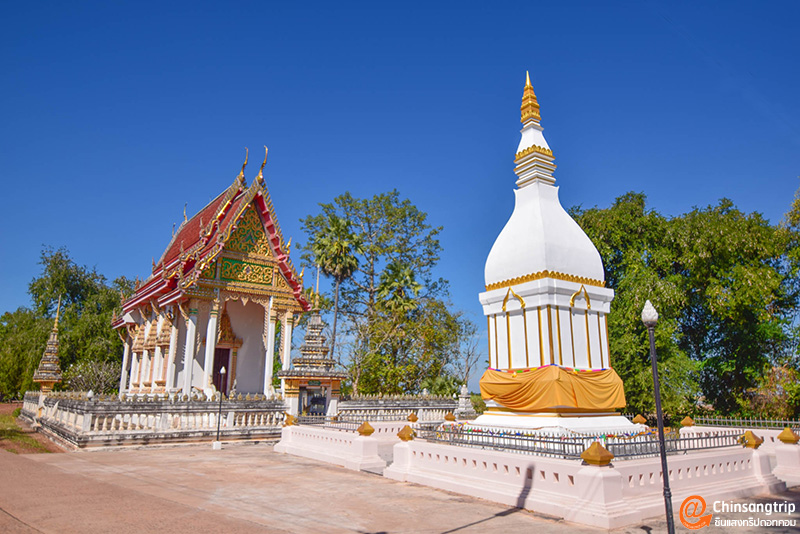
The Characteristics of Chom Sri Pagoda
The essence of the Chom Sri Pagoda is a living entity that reflects the history and culture of its locality. Its aged and significantly weathered characteristics speak volumes about the region´s past. Particularly remarkable and wondrous is the deteriorated state of the bricks at the base of the Chom Sri Pagoda, causing the foundations on all four sides to protrude unevenly, and the pagoda itself to lean noticeably. Despite this, the structure remains upright, and the exact origin of this distinctive feature has been lost to history.
Surrounded by this rich historical context, the Chom Sri Pagoda not only serves as a symbol of faith and reverence but also represents the resilience of the people of the ancient Khmer era, who placed great importance on creating pagodas in this unique fashion. Despite numerous alterations and decay, the Chom Sri Pagoda stands firm, depicting the strength of the religion and culture of that era."
The Beliefs of Wat Chomsiri
The residents of this region hold strong faith and belief in the sanctity of the sacred relic, particularly the "Phra That Chomsiri." It is revered with utmost respect, and if their descendants work in other regions or take up employment elsewhere, they make a point to pay their respects to the sacred relic, seeking blessings for success. Conversely, if anyone disrespects or acts unfavorably towards the relic, the belief is that unfortunate events may unfold. There have been instances where individuals who attempted to excavate the Buddha image from the sacred relic site experienced adverse consequences, reinforcing the sanctity of this belief. Relatives are therefore obliged to promptly return such artifacts to the temple.
The temple, where the "Phra That Chomsiri" is a significant edifice, serves as a focal point for the community´s religious activities. It is a place where locals come together to organize merit-making ceremonies, especially on the 6th day of the 6th month each year. On this auspicious day, a large number of people from all around gather to celebrate and show their respect for the sacred relic, particularly the revered Phra That Chomsiri.
Phra That Chom Si is one of the significant and sacred sites dating back to the years 2420-2430 B.E. This area gained attention from the local elder, who heard about the abundant natural resources in the Nong Han River Basin, including fertile land and food resources like rice and fish.
Motivated by this information, the elder decided to journey to the Nong Han River Basin, bringing along nine elephants. He had established a strong relationship with the community of Phra That Chom Si, where he eventually raised these elephants in the rubber tree forest near the school of Ban Lao Chala Nong Waeng. Unfortunately, all nine elephants eventually passed away here.
Afterward, the respected elder received recognition in the region and became known. He then founded the Chala Lao village, the birthplace of Phra Khru Suwanthamachada, the abbot of Wat That Chom Si at the time. In those days, he discovered a temple and a pagoda constructed with laterite bricks, preserving the simplicity and beauty of Thai art.
He gathered the local residents to help rebuild and added a roof to the pagoda to ensure its longevity. Over time, successive generations in the area coordinated efforts to maintain and preserve Phra That Chom Si. Monks also made pilgrimages to the site and contributed to the restoration of the temple, ensuring its continual well-being. Today, the locals refer to the temple as "Wat Nok."

The Characteristics of Chom Sri Pagoda
The essence of the Chom Sri Pagoda is a living entity that reflects the history and culture of its locality. Its aged and significantly weathered characteristics speak volumes about the region´s past. Particularly remarkable and wondrous is the deteriorated state of the bricks at the base of the Chom Sri Pagoda, causing the foundations on all four sides to protrude unevenly, and the pagoda itself to lean noticeably. Despite this, the structure remains upright, and the exact origin of this distinctive feature has been lost to history.
Surrounded by this rich historical context, the Chom Sri Pagoda not only serves as a symbol of faith and reverence but also represents the resilience of the people of the ancient Khmer era, who placed great importance on creating pagodas in this unique fashion. Despite numerous alterations and decay, the Chom Sri Pagoda stands firm, depicting the strength of the religion and culture of that era."
The Beliefs of Wat Chomsiri
The residents of this region hold strong faith and belief in the sanctity of the sacred relic, particularly the "Phra That Chomsiri." It is revered with utmost respect, and if their descendants work in other regions or take up employment elsewhere, they make a point to pay their respects to the sacred relic, seeking blessings for success. Conversely, if anyone disrespects or acts unfavorably towards the relic, the belief is that unfortunate events may unfold. There have been instances where individuals who attempted to excavate the Buddha image from the sacred relic site experienced adverse consequences, reinforcing the sanctity of this belief. Relatives are therefore obliged to promptly return such artifacts to the temple.
The temple, where the "Phra That Chomsiri" is a significant edifice, serves as a focal point for the community´s religious activities. It is a place where locals come together to organize merit-making ceremonies, especially on the 6th day of the 6th month each year. On this auspicious day, a large number of people from all around gather to celebrate and show their respect for the sacred relic, particularly the revered Phra That Chomsiri.


